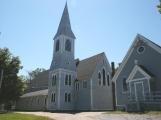1
Religion has always been an important unifying factor in the lives of Digby County inhabitants since the founding fathers first landed here in 1783. Churches are places both for worship and social interaction. Over the years there have been at times factional disputes. These centred around changes in dogma,ritual and various other forms of modernization. None have been more divisive than those involving moral values.Churches, like society in general, encounter and must grapple with a myriad of dilemmas in our rapidly changing world. It is a matter of either adapt, or lose all relevance.
Interest in the existing established churches has waned and members have dwindled resulting in some closed buildings. The core group remains dedicated and works hard to maintain its voice on many pressing contemporary issues. Spirituality is strong even amongst those who no longer attend services. The Judeo-Christian ethic of hard work and perseverance lives on.
4
The present building is the second one to be built on this site. Trinity Parish was created on Michaelmas Day, 1785 and was named after Trinity Parish in New York, which had been the home parish of many of the Loyalists who came to Digby.The cornerstone of both are placed side-by-side. The cornerstone for the first church was laid by Bishop Charles Inglis in 1788, the first one after his becoming Nova Scotia's first Anglican Bishop. He was well known by many of the parishioners as he had been their rector in their former homeland.
Rear Admiral Robert Digby had his own pew and the Digby Coat of Arms decorated the door. The first rector was Rev. Roger Viets of Connecticut. Despite hardships, the church membership expanded and by 1871 the church had become too small. In 1876 a group of disaffected parishioners left Trinity and built the Reformed Episcopal Church, thepresent United Baptist Church. Before long, many returned to the Trinity.
In 1878 the cornerstone of the present structure was laid. Under the directions of architect Stephen Earle of New England, Martin Oliver, a shipbuilder, erected the new church in 1880 on the same site as the original one. A distinctive feature of the new church is its ceiling resembling the inverted hull of a ship. It is a large wooden structure with a tall steeple on the north side and can accommodate 750 people. Stained glass windows each depicting scriptural scenes have been installed. The high content silver bell, given by Admiral Digby, lost its melodious tone when it was recast.
In 1904 the church hall was rebuilt to be used as a school to educate local children.

